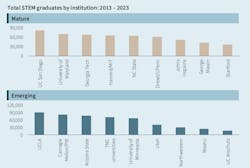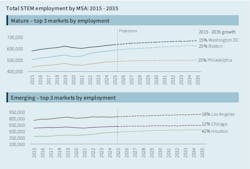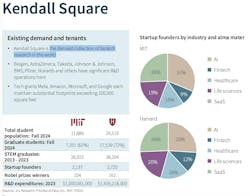University anchored innovation districts are a reliable real estate play
Innovation districts that are anchored by higher education institutions are self-sustaining ecosystems that offer robust investment prospects.
A just-released Jones Lang Lasalle-generated survey looks at 18 mature and emerging innovation districts anchored by 25 colleges and universities. It found that these districts represent “one of the most compelling and resilient real estate investment opportunities in today’s evolving commercial landscape.” JLL goes on to say that innovation districts anchored by top-tier research institutions “command substantial rent premiums across asset types, while maintaining lower vacancy rates than national and local market benchmarks.
The convergence of academic research excellence, diverse funding sources and strategic public-private partnerships creates a value proposition that provides a competitive advantage through proximity to cutting-edge research, specialized talent pipelines and complementary businesses.
JLL suggests several benefits from placing districts on or near college campuses. Universities serve as stable anchor tenants that produce predictable demand expectations to support consistent real estate development. Higher education research generates startup activity, new intellectual property and technologies that attract private sector investment. The continuous churn of undergraduate and graduate students coalesces into a concentrated and consistent pipeline of talent. And universities bring established public and private sector relationships that provide credibility and development resources, while their mixed-use environments create attractive ecosystems for occupiers and investors.
Magnets for public and private financing
This report comes out at a time when federal and state funding for university research is being scaled back or, at least, rethought, jeopardizing the logic underpinning these innovation districts. While conceding these pressures, JLL still sees “a robust funding landscape” for these research efforts that includes federal agencies like Health and Human Services, Defense, National Science Foundation, Energy, NASA, and Agriculture, which collectively accounted for 50% of higher education R&D funding as of 2023. State and local governments, nonprofits and private sector partners provide additional funding streams.
The combination of federal research dollars and private venture capital sources supports both university spinouts and scaling companies, driving demand for real estate across the innovation district. And Higher Ed institutions nestled within innovation district settings have demonstrated consistent resilience and growth, despite industry headwinds. Innovation district universities saw undergraduate enrollment grow by almost 17% from 2015 through 2023, while national overall enrollment declined 1.4%. Master’s degree completions similarly outpaced national trends. This positive momentum creates what JLL calls a “virtuous cycle” that also fosters increased research activity and entrepreneurship, leading to higher start-up activity and industry partnerships.
The universities that anchor innovation districts graduate an ample supply of science and engineering graduates at the bachelor’s, master’s and doctorate levels, building a steady pipeline of talent that drives growth within the ecosystem. This assembly line also creates unique opportunities for internships, co-op programs, and research collaborations. And metropolitan markets with innovation districts are better positioned for STEM employment growth through 2035. (JLL singles out Phoenix and Atlanta as examples.)
A solid mixed-use investment
Mature Innovation districts command a 36% premium on direct asking rents compared to national benchmarks. Within the local market, innovation district submarkets command a 26% office rent premium and average vacancy is 290 basis points lower. Limited high-quality inventory within these ecosystems drives pricing and high occupancy, creating resilient micro-markets that outperform even during market downturns.
University anchored innovation districts create premium retail submarkets that command a 28% premium over the broader local market. “Dense, walkable neighborhoods attract both students and professionals that drive sustained tenant demand for both traditional and experiential retailers,” states JLL.
The report includes three successful case studies: Kendal Square in East Cambridge, Mass., whose square mile encompasses the densest collection of biotech research in the world, and is near Harvard University and Massachusetts Institute of Technology, each with more than $1 billion in R&D spending in 2023; Pittsburgh Innovation District, home to hundreds of growth-stage tech companies and anchored by Carnegie Mellon University and the National Robotics Engineering Center; and Stanford Research Park on 700 acres in Palo Alto, Calif., with more than 140 buildings dedicated to high-tech research and development.
To tap into these and other ecosystems, JLL recommends that investors target talent-dense submarkets, adopt longer-term strategies, and embrace flexibility and mixed use. These innovation districts are best-suited to space occupiers that prioritize access to talent, leverage partnership opportunities, and invest in scalable workplace solutions. As for Higher Ed leaders and local governments, university anchored innovation districts provide opportunities to connect campuses to communities, foster P3s, and drive policy improvements.
About the Author

John Caulfield
John Caulfield is Senior Editor with Building Design + Construction Magazine.



